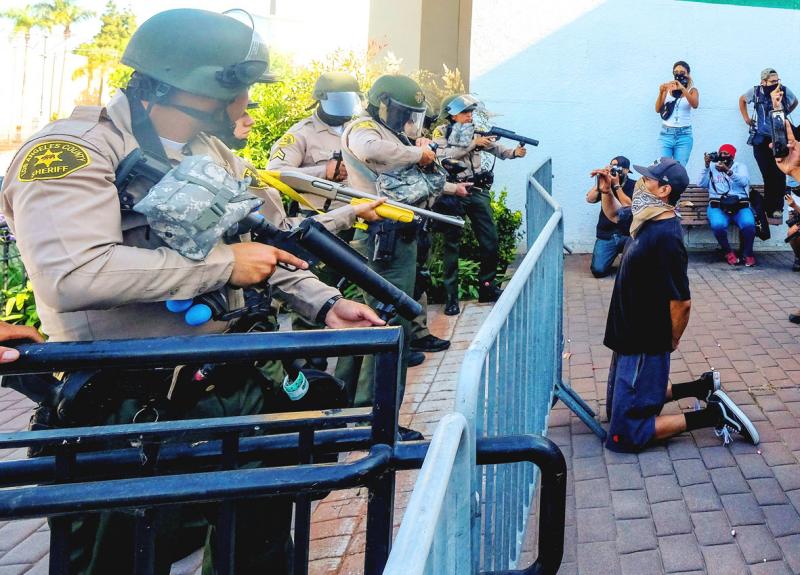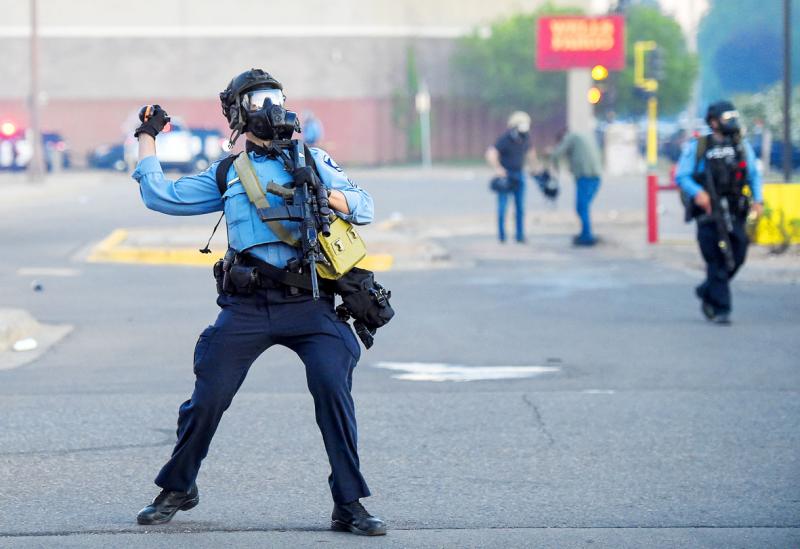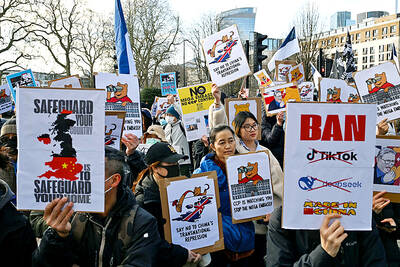In Silver Spring, Maryland, fireworks can still be heard months after they first began and well past the Fourth of July holiday.
“When it comes to the theory of cops being involved, I wouldn’t put it past them,” said Ira, who participates in protests and activism in Silver Spring.
Ira, who prefers to use only a first name because of fear of police reprisal, is referring to a theory that became especially popular on Twitter, which posited police were supplying or abetting the recent onslaught of fireworks in major cities in an effort to exhaust and agitate protesters during the peak of the response to George Floyd’s murder.

Photo: Reuters
The use of sound as a form of control is in the spotlight due to potentially harmful military-grade weapons such as flash-bangs and long-range acoustic devices (LRADs) being utilized with accelerating regularity at protests across the US.
Luna, an activist who is only using her first name out of fear of doxxing, has been on the frontlines of direct actions against police brutality in Portland, Oregon, for nearly two months.
She said the Portland police’s use of flash-bangs, which can produce sounds as loud as 170 decibels — a jet taking off is 150 decibels, for comparison — has left her with symptoms of post-traumatic stress disorder.

Photo: EPA-EFE
“If I’m in public and I hear a loud bang, I’ll stop and duck and look around,” she said.
Luna said the fireworks set off in Portland trigger the same response for her and the other protesters who rally each night.
“It’s very exhausting, not just physically, but mentally,” she said.
Sound studies experts say that while LRADs and flash-bangs are worrisome tactical escalations that can permanently injure people by rupturing eardrums, they are rooted in the long, uncontested tradition of the state utilizing sound as a means of social, cultural and political control.
Even sounds heard since childhood can be used to send signals in certain communities.
Briana Thompson, who has been participating in protests in Phoenix, Arizona, said: “As a black person in America, I always have a heightened and triggered response to police sirens.”
Originally from Brazil, the sound researcher Pedro Oliveira has studied the Brazilian military police’s use of sound bombs, or stun grenades, against communities of color in Sao Paulo as a “material articulation of racialized sonic violence.”
He said a police siren in a white neighborhood can mean protection and in a non-white neighborhood can mean threat.
“Sirens and whistles function more as devices for crowd control and establishing social order,” Oliveira said. “[LRAD] performs similar functions, like organization and control, but the step ahead is that it is meant to hurt.”
This “step ahead” troubles Marisa Ewing-Moody, an audio engineer based in Washington.
After seeing the LRAD deployed at protests, she detailed its history and specs on Twitter. She especially takes issue with its designation as a non-violent form of crowd control.
“You can cause permanent damage to people that are exposed to this,” she said. “I wouldn’t say that’s non-violent.”
Ewing-Moody said that Genasys, the company that creates LRADs, brags about the LRAD reaching 30 decibels higher than typical vehicle PA systems.
“The context of 30 dB being the difference between those two points is astronomically huge,” she said.
A typical concert sits in the range of 85 to 88 decibels, she said.
LRADs are capable of almost doubling that.
Besides the implied hearing damage, Ewing-Moody said that our ears mediate other bodily functions such as balance.
“If you’re in a scenario where your ears are being damaged, that can cause dizziness and nausea because your body is getting confused by the way your inner ear is moving,” she said.
Besides these ramifications, Oliveira said sound is useful as a tool of social control because it is not just perceived by the ears, but by the whole body.
“It’s difficult to describe in physical terms what sound can do,” he said.
A siren’s warble, for example, is not intrinsically connected to fear, but given its use over time as a sound that often precedes violence, it causes a fear reaction.
Thompson gives another example: the roar of police helicopters flying overhead.
She and others chose to observe eight minutes of silence while lying in the street in downtown Phoenix, Arizona, a solemn tribute to the length of time during which Minneapolis police officers killed Floyd.
“It was a beautiful sight, but that silence wasn’t actually silent,” she said, as police helicopters overhead filled their ears, while police in riot gear marshalled nearby.
“We [were] outside in the middle of our city, but it was claustrophobic and terrifying lying there listening to police hover above us and close in around us,” she said.
James Parker, a senior lecturer at Melbourne Law School, said examples like Thompson’s show that the weaponization of sound is problematic beyond just the possible physical harm to our ears.
“[It’s] a context in which we understand a protester as the aggressor who needs to be managed en masse,” he said, despite the fact that “time and time and time again, we see that it’s police action which produces the violence [or] antagonism that they claim to be policing.
“I think the LRAD gets an undue amount of attention in some ways,” Parker said. “The thing about the LRAD is that it asserts a physical force over you. You’re literally compelled to run away. That’s a very new, strange thing in some ways, but it’s much more continuous with a siren or a whistle than it is with a gun.”

The team behind the long-awaited Vera Rubin Observatory in Chile yesterday published their first images, revealing breathtaking views of star-forming regions as well as distant galaxies. More than two decades in the making, the giant US-funded telescope sits perched at the summit of Cerro Pachon in central Chile, where dark skies and dry air provide ideal conditions for observing the cosmos. One of the debut images is a composite of 678 exposures taken over just seven hours, capturing the Trifid Nebula and the Lagoon Nebula — both several thousand light-years from Earth — glowing in vivid pinks against orange-red backdrops. The new image

Canada and the EU on Monday signed a defense and security pact as the transatlantic partners seek to better confront Russia, with worries over Washington’s reliability under US President Donald Trump. The deal was announced after a summit in Brussels between Canadian Prime Minister Mark Carney and European Commission President Ursula von der Leyen and European Council President Antonio Costa. “While NATO remains the cornerstone of our collective defense, this partnership will allow us to strengthen our preparedness ... to invest more and to invest smarter,” Costa told a news conference. “It opens new opportunities for companies on both sides of the

ESPIONAGE: The British government’s decision on the proposed embassy hinges on the security of underground data cables, a former diplomat has said A US intervention over China’s proposed new embassy in London has thrown a potential resolution “up in the air,” campaigners have said, amid concerns over the site’s proximity to a sensitive hub of critical communication cables. The furor over a new “super-embassy” on the edge of London’s financial district was reignited last week when the White House said it was “deeply concerned” over potential Chinese access to “the sensitive communications of one of our closest allies.” The Dutch parliament has also raised concerns about Beijing’s ideal location of Royal Mint Court, on the edge of the City of London, which has so

OVERHAUL: The move would likely mark the end to Voice of America, which was founded in 1942 to counter Nazi propaganda and operated in nearly 50 languages The parent agency of Voice of America (VOA) on Friday said it had issued termination notices to more than 639 more staff, completing an 85 percent decrease in personnel since March and effectively spelling the end of a broadcasting network founded to counter Nazi propaganda. US Agency for Global Media (USAGM) senior advisor Kari Lake said the staff reduction meant 1,400 positions had been eliminated as part of US President Donald Trump’s agenda to cut staffing at the agency to a statutory minimum. “Reduction in Force Termination Notices were sent to 639 employees at USAGM and Voice of America, part of a